Difference Between Caesarstone and Quartz
Thinking about remodeling your kitchen? Kitchen is arguably the most important space in your house because this is the place where the meals are made and the memories are created. So, the importance of a nice and visually appealing kitchen design cannot be overstated. Kitchen design is about filling in the right design elements and when it comes to kitchen aesthetics, countertops play an increasingly important role in the modern kitchen. There are several choices in countertops, from the less-expensive laminate to wood and concrete to high-end granite and quartz.

What is Caesarstone?
Caesarstone is one of the world’s most recognized and desirable brands of engineered quartz. It is a pioneer of quartz countertops which transforms one of the earth’s most abundant natural minerals into durable, fashionable and world-class countertop surfaces. Founded in 1987 and originated in Sdot Yam Kibbutz alongside the Roman city of Caesarea, Caesarstone is the leader of world’s finest quartz surfaces. Caesarstone is basically an engineered stone based on an Italian industrial process that molds quartz aggregates, sand, glue and resin into slabs.
Caesarstone countertops are used in homes all over the world, especially in kitchen countertops, offering endless design possibilities and extensive color palettes to create a perfect space of interaction and creativity. Caesarstone is also the most professional choice for bathroom vanities, tabletops, wall paneling, and more. However, since the product contains a high percentage of crystalline silica, it poses some serious health risks to the workers who cut, size, grind, and polish the stone. The company’s production facilities are located at Israel and USA, with warehouses and refinery plants located at Shenzhen, Beijing, Shanghai, and Honk Kong.

What is Quartz?
Quartz is one of the most abundant minerals found in the earth’s crust. It can be found anywhere where there’s dirt and it is widely used as raw materials in several industrial fields. It is silicon based mineral that is composed of one part silicon and two parts oxygen. It is one of the harder types of minerals of the earth’s crust, and they are important industrial raw materials. It is very common like sand but tougher than steel. Owing to their abundance and physical and chemical properties, quartz is used in a wide range of industrial and technological applications, especially countertops.
Quartz is widely used in kitchen countertops because like other hard surface countertop materials, quartz is unscratchable, non-porous, non-staining, does not need to be sealed and will not scorch or mar from high heat. It is as tough as granite and it has more inherent flexibility, which makes it very resistant to cracks and scratches. The surface is cool to the touch, like granite and marble. Quartz countertops have become immensely popular as granite alternatives. Unlike granite, they are extremely stain-resistant, so you do not have to worry if you accidentally spill a glass of wine on it. You can simply wipe off the stain quickly and you are good to go.
Difference between Caesarstone and Quartz
Type
– Quartz is a type of engineered stone widely used as a premium choice of material in kitchen and bathroom surfaces because of its non-porous characteristics. Natural quartz is one of the most abundant minerals found in the earth’s crust and the ones used for surface materials are engineered quartz made from 93 percent natural quartz and 7 percent pigments, binders and resins. Caesarstone, on the other hand, is one of the world’s most recognized and desirable brands of engineered quartz which makes world-class countertop surfaces from the earth’s most common mineral.
Properties
– Like other natural stones like granite, quartz is as tough as granite and is extremely heat resistant and scratch resistant, which makes it a durable choice of material for kitchen surfaces. Quartz is non-porous and it does not need to be sealed, and it will not scorch or mar from high heat. It is also highly stain resistant, which means you do not need to worry if you accidentally spill some wine on it; simply wipe it off and you’re good to go. Caesarstone is an engineered stone made from processed quartz and offers endless design possibilities and extensive color palettes, unlike other natural stones.
Which one’s better for countertops?
Quartz countertops are popular granite substitutes that resemble solid-surface countertops, but with a higher constituent of minerals versus plastic resins and binders. Quartz is one of the most popular choices of material for kitchen countertops and Caesarstone is one of the world’s largest producers of quartz kitchen countertops who gives shape to the earth’s most abundant minerals and brings them to your home. Quartz is one of the hardest natural minerals found in the earth’s crust, making it a durable material for kitchen countertops. One of the best things about quartz is the abundance of color choices and the consistency it provides in the slabs is truly unmatched.
Caesarstone vs. Quartz: Comparison Chart

Summary
In a nutshell, quartz is one of the most common and hardest natural minerals found in the earth’s crust, and Caesarstone takes those raw quartz minerals and transforms them into exquisite, timeless items such as kitchen countertops, bathroom vanities, tabletops, wall paneling, and more. Quartz is beautiful, versatile and durable, making it a great choice for kitchen countertops and breathing life into your cooking space. Quartz is extremely heat resistant and scratch resistant, and stain resistant, so you do not have to worry about accidental spills
- Difference Between Caucus and Primary - June 18, 2024
- Difference Between PPO and POS - May 30, 2024
- Difference Between RFID and NFC - May 28, 2024
Search DifferenceBetween.net :
Leave a Response
References :
[0]Götze, Jens. Mineralogy of Quartz and Silica Minerals. Basel, Switzerland: MDPI, 2018. Print
[1]Ross, Andrew. Stone Men: Palestinians Who Built the Houses of Zion. New York, United States: Verso Books, 2019. Print
[2]Black & Decker The Complete Guide to Kitchens. California, United States: Cool Springs Press, 2009. Print
[3]Image credit: https://live.staticflickr.com/4447/23924522358_067f98dc4b_b.jpg
[4]Image credit: https://live.staticflickr.com/5116/7205473344_59b204fbac_b.jpg
